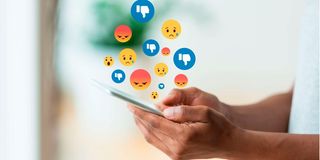How to protect yourself from online violence

Prominent women with an active social media presence often have to contend with online-gender-based violence.
What you need to know:
- #Shepersisted, an international organisation advocating for safer digital platforms, recently released a ‘Digital Resilience Toolkit for Women’.
- It advises that practising digital hygiene before attacks occur is the best target for minimising harms of online attacks.
Prominent women with an active social media presence often have to contend with online-gender-based violence (OGBV).
With a recent UN Women global study revealing that 85 per cent of women, who are online, have witnessed online violence being perpetrated against other women, digital resilience has become an essential skill for most women.
Wanjiru Nguhi, the Program Manager at Fumbua, Baraza Media Lab has an active social media presence on Twitter and has had her fair share of online violence and dealing with online misogynists.
“There are times during pervasive attacks, when a response is warranted. This gives you the opportunity to expose abuse and push back on the perpetrators, platforms and general misogynistic narratives. However, different incidents of harassment call for varied responses. Sometimes, responding to harassment can be dangerous as this could risk amplifying the abuse,’’ Ms Nguhi said in an interview with the Nation.
How can you discern the appropriate response when facing online violence?
#Shepersisted, an international organisation advocating for safer digital platforms, recently released a ‘Digital Resilience Toolkit for Women’ following their Monetised Misogyny report that implicated social media platforms for profiting off technology-facilitated gender-based violence.
The toolkit explains digital security and tactics for preventing, handling and reporting online harms, especially for women in public spaces such as elected leaders, journalists and human rights activists.
#Shepersisted advises that the first step towards protecting women online users from OGBV is strengthening their digital security. Although it can never be a fool proof measure, practising digital hygiene before attacks occur is the best target for minimising harms of online attacks.
Audit your own social media account
Before entering the public eye or as soon as possible, audit your own social media accounts and delete anything you wouldn’t want circulated widely. You can also set up Google alerts for your personal information to know if it ever appears online and track what is circulating about you.
Create multiple accounts
You should create separate public and private profiles where your public account is reserved for content you wish to communicate professionally. All personal information that you would have shared with your friends and family before having a public platform, should be kept to a private account. Your private account should have the strongest privacy settings and ideally should not be immediately recognizable as you.
Create a strong unique password
The guide recommends the creation of a strong and unique password for every platform that you are on. Whichever the user chooses should at least be 16 characters, contain a mix of upper and lower case letter symbols and numbers.
“Avoid using familiar names or places in your passwords and swapping out letters for correlative numbers or symbols (for example @ for a).Think of creating a ‘passphrase’ rather than a ‘password’, including a sentence or an array of words instead of a word,” reads part of the guide.
Enable multi-factor authentication on all your accounts
A multi-factor authentication is a layer of security that prompts you for confirmation on a second device before you can access your account. Applications like Google already have an inbuilt authenticator that you can use to create this second layer of security.
Beware of spam emails
Be cautious when opening unexpected emails or messages. Don’t open unexpected links or attachments without verifying them with the sender on a separate platform. When possible, avoid allowing access to your accounts from third-party apps or services. When places ask you to “sign in via Google or Facebook,” create a separate account instead.
After bolstering your digital security, the guide recommends a range of reporting actions that women can take in case they find themselves in the midst of an online attack. Most survivors of online violence are tempted to delete the abuse in an attempt to curb the spread of the attack. However, the toolkit recommends that this is not the right action to take.
“Even though it may feel counterintuitive, the best thing you can do is document all the online abuse you receive. By keeping a record, you have evidence of the perpetrators, can observe patterns in abuse, and have evidence if you decide to report the abuse to your employer, the platforms or law enforcement,’’ reads part of the toolkit.
Among the messages that should be documented include threatening or harassing emails, texts, phone calls, screenshots and hyperlinks of social media posts and messages. After collecting the evidence, #Shepersisted recommends that you create an online document that highlights the date, time and where the attacks occurred.
Although the toolkit recognises that social media companies should bear the burden of ensuring their users, including women, are safe on their platforms, the guide hopes to support women who find themselves facing online violence.





